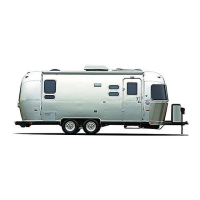
Do you have a question about the Airstream 2013 International and is the answer not in the manual?
| Brand | Airstream |
|---|---|
| Model | 2013 International |
| Category | Motorhomes |
| Language | English |
Explains the manual's goal to assist with operation, function, and care of the trailer systems.
Acknowledges varying customer skill levels for repairs and maintenance.
Brief explanations of appliance operation are provided, with more detail in manufacturer literature.
Manual content is based on latest product information at publication approval.
Emphasizes reading and obeying all safety messages in the manual.
Warning against allowing passengers to ride in the trailer during travel.
Advice on controlling trailer sway or fishtailing for safety.
Guidance on controlling mold growth by managing moisture.
Importance of proper weight distribution for efficient towing.
Procedure for proper tightening and checking of lug nuts.
Explains causes of wheel separation, such as improper lug nut torque.
Safety precautions for propane-powered appliances and equipment.
Importance of proper tire maintenance for vehicle performance and safety.
Discusses chemical sensitivity from new products and the importance of ventilation.
Details formaldehyde as a substance and its presence in RVs.
Importance of ventilation to reduce exposure to chemicals and off-gassing.
Recommendation against smoking inside the RV due to toxic chemicals.
Explains the duration and scope of the limited warranty.
Defines limitations on implied warranties like merchantability and fitness.
Lists components and conditions not covered by the limited warranty.
Specific exclusions include tires, batteries, and normal wear.
Steps required to obtain warranty service for defects.
Disclaims responsibility for incidental and consequential damages.
Procedure for reporting safety defects to NHTSA and Airstream.
Schedule for routine maintenance based on mileage or time intervals.
Items like tires and upholstery are excluded if worn due to normal use.
Recommends specific towing options for tow vehicles.
Discusses advantages of automatic transmissions for towing.
Regular inspection of the hitch for loose parts or damage.
Tips on packing efficiently and consolidating items for towing.
Information on how electric trailer brakes operate.
Guidance on adjusting the brake controller for optimal braking.
Instructions for maintaining the trailer's break-away switch.
Warning about the dangers of accidental trailer separation.
Critical importance of proper load balancing for safe handling.
Procedure for weighing the trailer on scales to check axle weights.
Explains the importance of tongue weight and how to measure it.
Step-by-step guide for hitching the trailer to the tow vehicle.
Recommendation for using sway control devices for stability.
Advice on practicing turns, backing, and general driving.
Techniques and corrective measures for dealing with trailer sway.
A comprehensive checklist for preparing the trailer before travel.
Instructions for operating escape windows and checking escape routes.
Information on fire extinguishers, smoke detectors, and LP gas safety.
Guidance for parking and securing the trailer for an overnight stay.
Detailed steps for leveling the trailer side-to-side and front-to-rear.
Instructions for connecting to city water, power, and sewer.
Warning regarding potential hydrogen gas production in hot water systems.
Instructions for connecting cable TV and installing a satellite system.
Essential precautions for traveling in sub-freezing temperatures.
Tips and methods for managing and reducing condensation inside the trailer.
Information on what causes mold growth and how to prevent it.
Factors affecting sway and corrective measures to maintain control.
Recommended methods for washing and waxing the trailer exterior.
Warning against using abrasive polishes or strong cleaning solvents.
Instructions for operating the main door and securing it while towing.
Cleaning and maintenance of exterior windows and seals.
Instructions for using the power jack and associated safety warnings.
Information on axle maintenance and alignment specifications.
Details on the electric brake system and controller operation.
Guidance on tire care, pressure checks, and changing tires.
Importance of proper lug nut torque and the sequence for tightening.
Warning about potential wheel separation and required checks.
Information on the spare tire storage and carrier.
Safety precautions and hazard awareness for rear cargo loading.
Methods for securing cargo properly within the trailer.
Information and safety warnings for the exterior LPG port.
Explanation of different cleaning codes for upholstery fabrics.
Guidance on cleaning carpets, vinyl floors, and countertops.
Safety warnings related to fire hazards and smoke alarm maintenance.
Information on the LP gas detector, its function, and low voltage warning.
Details on carbon monoxide alarms, their function, and safety.
Instructions for operating exterior windows and escape windows.
Maintenance of screens and information on the satellite radio option.
Explanation of the inverter's function and overload protection.
Information on LPG connections, valves, and safety rules.
Procedure for removing and installing LPG bottles.
Explanation of the automatic gas regulator and its indicator.
Essential safety rules for using LPG systems.
Steps to follow if LPG gas is detected.
Instructions for filling and using the self-contained water system.
Procedure for sanitizing the fresh water tank with bleach.
Connecting to an external city water source.
Information on the galley faucet, its maintenance, and filter.
Locations of drain valves for various trailer models.
Procedure for emptying black and gray water tanks.
Comprehensive steps to winterize the plumbing system.
Locations of the water heater bypass valve for winterizing.
How to operate the RV toilet and perform basic maintenance.
Explains the primary 12-volt power sources and distribution.
Function and operation of the battery disconnect switch.
Guidelines for checking, cleaning, and maintaining the trailer battery.
Shows battery freezing points based on charge level.
Details on the converter/charging system and its role.
Overview of 12V circuits and fuse inspection.
Information on the 120V AC panel and circuit breakers.
Instructions for raising, rotating, and lowering the TV antenna.
Wiring diagrams for antenna, cable, and satellite TV connections.
Information regarding the optional solar panel system.
Details on monitor panels for tank levels and battery status.
Explanation and testing procedures for GFCI protection.
Importance of appliance manuals and annual maintenance.
Warning about potential fire or explosion with LP gas appliances near fuel sources.
Information on AC operation, voltage requirements, and placement.
Details on furnace operation, LP gas usage, and safety warnings.
How the refrigerator works, including leveling and fan operation.
Information on the water heater, including hydrogen gas warning.
Operation and benefits of the high-volume roof vent system.
Definitions of GVWR, UBW, NCC, and GAWR.
How to determine the maximum cargo weight for your trailer.
Explanation of the Tire & Loading and Vehicle Manufacturing tags.
Specific cold tire inflation pressures for different tire sizes.
Table detailing dimensions, weights, and capacities by trailer model.
Procedure for measuring and setting the correct hitch ball height.
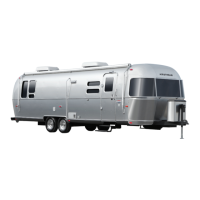
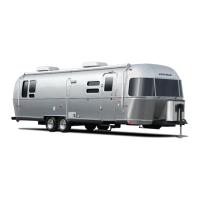
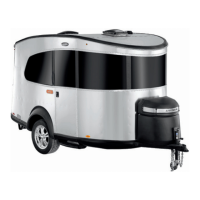


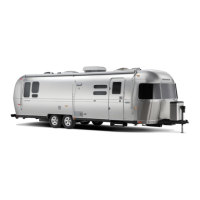
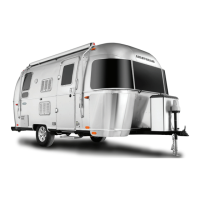
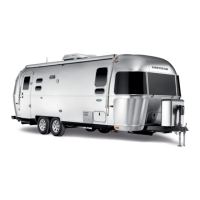
